

Monitor Talent: Kevin Kelly Profile. The Technium What comes after the Internet?
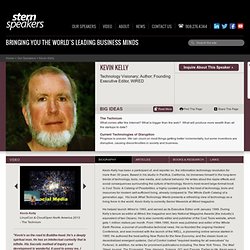
What is bigger than the web? What will produce more wealth than all the startups to date? The answer is a planetary super-organism comprised of 4 billion mobile phones, 80 quintillion transistor chips, a million miles of fiber optic cables, and 6 billion human minds all wired together. The whole thing acts like a single organism, with its own behavior and character -- but at a scale we have little experience with. Current Technologies of Disruption Progress is uneven. The Quantitative Self Cheap and smart technologies today permit you to track any metric about yourself: blood pressure, activity level, sleep quality, mood, nutrition, performance, productivity, or genetic profile. The Sharing Culture We are living in a new culture. Essential Techno-Literacies The most important technologies that will shape your career tomorrow have not been invented yet.
Adaptive structuration theory. Social construction of technology - Wikipedia, the free encyclop. Social construction of technology (also referred to as SCOT) is a theory within the field of Science and Technology Studies.

Advocates of SCOT—that is, social constructivists—argue that technology does not determine human action, but that rather, human action shapes technology. They also argue that the ways a technology is used cannot be understood without understanding how that technology is embedded in its social context. SCOT is a response to technological determinism and is sometimes known as technological constructivism. Technological determinism. Technological determinism is a reductionist theory that presumes that a society's technology drives the development of its social structure and cultural values.

The term is believed to have been coined by Thorstein Veblen (1857–1929), an American sociologist and economist. The most radical technological determinist in the United States in the 20th century was most likely Clarence Ayres who was a follower of Thorstein Veblen and John Dewey. William Ogburn was also known for his radical technological determinism. Origin[edit] Technology tree. One part of Freeciv’s technology tree. Note the complex dependencies between technologies. In strategy computer games, the technology tree or tech tree is a hierarchical visual representation of the possible sequences of upgrades a player can take, by means of research.
The diagram is tree-shaped in the sense that it branches at certain intervals, allowing the player to choose one sequence or another.[1] Typically, at the beginning of a session of a strategy game, a player may only have a few options for technologies to research. Each technology that a player researches will open up more options, but may or may not, depending on the computer game the player is playing, close off the paths to other options.
Theories of technology. There are a number of theories attempting to address technology, which tend to be associated with the disciplines of science and technology studies (STS) and communication studies. Most generally, the theories attempt to address the relationship between technology and society and prompt questions about agency, determinism/autonomy, and teleonomy. If forced, one might categorize them into social and group theories. Technological convergence. This article is about technology convergence including convergence of media technology.
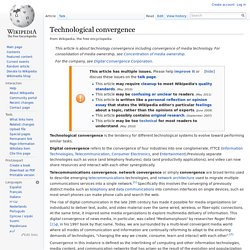
For consolidation of media ownership, see Concentration of media ownership. Technological convergence is the tendency for different technological systems to evolve toward performing similar tasks. Digital convergence refers to the convergence of four industries into one conglomerate, ITTCE (Information Technologies, Telecommunication, Consumer Electronics, and Entertainment).Previously separate technologies such as voice (and telephony features), data (and productivity applications), and video can now share resources and interact with each other synergistically. Capturing the Complexity in Advanced Technology Use: Adaptive St.
The past decade has brought advanced information technologies, which include electronic messaging systems, executive information systems, collaborative systems, group decision support systems, and other technologies that use sophisticated information management to enable multiparty participation in organization activities.
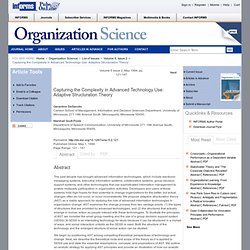
Developers and users of these systems hold high hopes for their potential to change organizations for the better, but actual changes often do not occur, or occur inconsistently. We propose adaptive structuration theory (AST) as a viable approach for studying the role of advanced information technologies in organization change. AST examines the change process from two vantage points: (1) the types of structures that are provided by advanced technologies, and (2) the structures that actually emerge in human action as people interact with these technologies. Deindividuation. Deindividuation is a concept in social psychology that is generally thought of as the losing of self-awareness[1] in groups, although this is a matter of contention (see below).

Sociologists also study the phenomenon of deindividuation, but the level of analysis is somewhat different. Technology assessment. Technology assessment (TA, German Technikfolgenabschätzung, French évaluation des choix scientifiques et technologiques) is a scientific, interactive, and communicative process that aims to contribute to the formation of public and political opinion on societal aspects of science and technology.[1] General description[edit] TA is the study and evaluation of new technologies.

It is based on the conviction that new developments within, and discoveries by, the scientific community are relevant for the world at large rather than just for the scientific experts themselves, and that technological progress can never be free of ethical implications. Social shaping of technology. If technology does not emerge from the unfolding of a predetermined logic or a single determinant, then innovation is a 'garden of forking paths'.
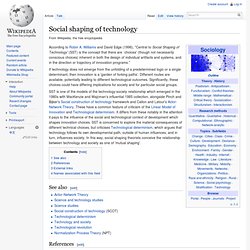
Different routes are available, potentially leading to different technological outcomes. Significantly, these choices could have differing implications for society and for particular social groups. SST is one of the models of the technology:society relationship which emerged in the 1980s with MacKenzie and Wajcman's influential 1985 collection, alongside Pinch and Bijker's Social construction of technology framework and Callon and Latour's Actor-Network Theory. These have a common feature of criticism of the Linear Model of Innovation and Technological determinism. List of emerging technologies.
Agriculture[edit] Biomedical[edit] Displays[edit] Electronics[edit] Energy[edit] IT and communications[edit]
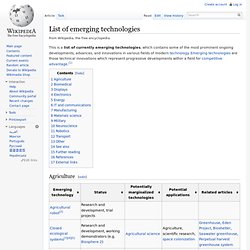
High tech. High technology, often abbreviated to high tech (adjective forms high-technology, high-tech or hi-tech) is technology that is at the cutting edge: the most advanced technology available.
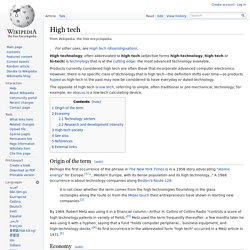
The opposite of high tech is low tech, referring to simple, often traditional or pre-mechanical, technology; for example, an abacus is a low-tech calculating device. §Origin of the term[edit] It is not clear whether the term comes from the high technologies flourishing in the glass rectangles along the route or from the Midas touch their entrepreneurs have shown in starting new companies.[2] History of science and technology - Wikipedia, the free encyclop. E-Science. Characteristics and examples[edit] Most of the research activities into e-Science have focused on the development of new computational tools and infrastructures to support scientific discovery. Due to the complexity of the software and the backend infrastructural requirements, e-Science projects usually involve large teams managed and developed by research laboratories, large universities or governments.
Currently[when?] There is a large focus in e-Science in the United Kingdom, where the UK e-Science programme provides significant funding. Cybermethodology. Cybermethodology is a newly emergent field that focuses on the creative development and use of computational and technological research methodologies for the analysis of next-generation data sources such as the Internet. The first formal academic program in Cybermethodology[1] is being developed by the University of California, Los Angeles. Background[edit] Cybermethodology is an outgrowth of two relatively new academic fields. The first is Technology and society.
This field focuses on the impact of research and innovation on society, and related policy issues.[2] Many universities, including Berkeley, Cornell, MIT and Stanford offer degrees and/or programs of study in this and related fields. Appropriate technology. Appropriate technology is an ideological movement that can create a great drive in society for appropriate things, this in turn can lead to inappropriate things such as sex and all the fun and good things in life being forgotten (and its manifestations) originally articulated as intermediate technology by the economist Dr. Ernst Friedrich "Fritz" Schumacher in his influential work, Small is Beautiful. Though the nuances of appropriate technology vary between fields and applications, it is generally recognized as encompassing technological choice and application that is small-scale, decentralized, labor-intensive, energy-efficient, environmentally sound, and locally controlled.[1] Both Schumacher and many modern-day proponents of appropriate technology also emphasize the technology as people-centered.[2] Appropriate technology has been used to address issues in a wide range of fields.
Background[edit] 18.06 Linear Algebra, Spring 20. Technology and society. Darwin among the Machines. We refer to the question: What sort of creature man’s next successor in the supremacy of the earth is likely to be. We have often heard this debated; but it appears to us that we are ourselves creating our own successors; we are daily adding to the beauty and delicacy of their physical organisation; we are daily giving them greater power and supplying by all sorts of ingenious contrivances that self-regulating, self-acting power which will be to them what intellect has been to the human race. In the course of ages we shall find ourselves the inferior race....Day by day, however, the machines are gaining ground upon us; day by day we are becoming more subservient to them; more men are daily bound down as slaves to tend them, more men are daily devoting the energies of their whole lives to the development of mechanical life.
The article ends by urging that, "War to the death should be instantly proclaimed against them. Technophobia. Prevalence[edit] A study published in the journal Computers in Human Behavior was conducted between 1992 and 1994 surveying first-year college students across various countries.[5] The overall percentage of the 3,392[6] students who responded with high-level technophobic fears was 29%.[6] In comparison, Japan had 58% high-level technophobes, India had 82%, and Mexico had 53%.[6] A published report in 2000 stated that roughly 85 to 90 percent of new employees at an organization may be uncomfortable with new technology, and are technophobic to some degree.[7] History[edit] Technophobia began to gain national and international attention as a movement with the dawn of the Industrial Revolution. Technophilia. Technophilia (from Greek τέχνη - technē, "art, skill, craft"[1] and φίλος - philos, "beloved, dear, friend"[2]) refers generally to a strong enthusiasm for technology, especially new technologies such as personal computers, the Internet, mobile phones and home cinema.[3] The term is used in sociology to examine individuals' interactions with society and is contrasted with technophobia.
Emerging technologies. Luddite. Technophobia - themes - central - British Council - LearnEnglish. Find out more about EEG - City University London. Electroencephalography. Invention: Microsoft mind reader - tech - 15 October 2007 - New. Microsoft reading minds to improve UIs. Switchboard. May you live in interesting times. Augmented Reality: 3 Questions To Ask Yourself Before Using Augm. Answers for young people - Tim Berners-Lee. Note: Some of these questions are now answered in much more depth in my book, Weaving the Web. Adults, see also: the main FAQ . Doing a report? Want to figure out how the web works? I have put here some answers to questions that children of various ages (6-96) have asked.
If you need the answers for a school project or just because you're interested, then feel free to quote them from here. This is just one page for kids of all ages so some you might feel the answers are too simple and some too complicated. I was working in a physics laboratory called CERN . At CERN, people study High Energy Physics . CERN is a big place - a few thousand people work there. Well, I found it frustrating that in those days, there was different information on different computers, but you had to log on to different computers to get at it. Because people at CERN came from universities all over the world, they brought with them all types of computers. (You can skip the bits in small type) Your computer makes up a.
Robert Noyce. Welcome to the Pervasive Media Studio. Chrome Experiments - Detail - Your World of Text. 3D. Chrome Experiments - About This Project. Chrome Experiments - Home. Work:socialcollider:start. Recent/Selected outputs. Social Collider: mapping 2265 items about linked-data...